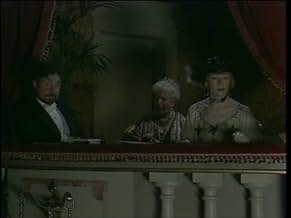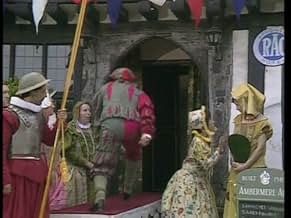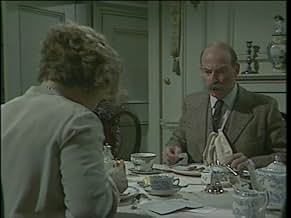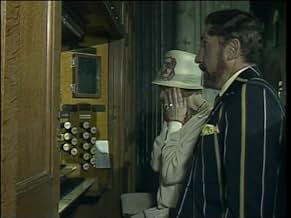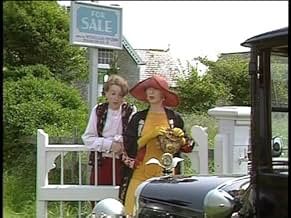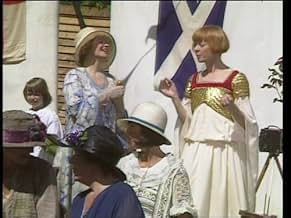Ajouter une intrigue dans votre langueThe social rivalry between two women in the 1930s when Lucia moves to the small English town of Tilling.The social rivalry between two women in the 1930s when Lucia moves to the small English town of Tilling.The social rivalry between two women in the 1930s when Lucia moves to the small English town of Tilling.
- Nomination aux 1 BAFTA Award
- 1 nomination au total
Parcourir les épisodes
Avis à la une
People seem to be trying to analyse this series to death, at the end of the day it is simply a wonderful comedy of manners, wonderfully acted and beautifully presented. The principles are all actors of great experience and charisma, working with almost infallible material. If you want slapstick or alternative humour, this is not the place for you! If you love watching a comedy where it is the actors who make the script brilliantly funny, rather than simply being given punchlines to deliver, then you should be in seventh heaven. Watch, relax, enjoy.
E.F. Benson could never have figured that his "Mapp & Lucia" novels would have been so deliciously brought to life by Channel Four, in the television series by the same name.
For those who are especially aware of the stock 1920-30's characters (with a Mayfair edge, particularly), "Mapp & Lucia" is a treat. From the soignee social arbiter, the tweedy local matron, the all-too-effeminate best friend (petit-point tatting in hand), the ironing-board thin outre artist (a nod to Radcliffe Hall) to the supporting cast of local dwellers, "Mapp & Lucia" revels in its atmospheric production.
When given the talents of Prunella Scales, Dame Geraldine McEwan and Sir Nigel Hawthorne, who play the title characters respectively (the latter, Georgino mio), it is little wonder that the shows transport one to the mignon village of Tilling, circa 1930. And the staging is so tongue-in-cheek, that certainly the Royal National would not have been ashamed to produce it. All in all, a curio of social manners set with more aplomb than "You rang, m'lord?" (1991) and more asperity than "Jeeves and Wooster" (1989) of the same ilk.
For those who are especially aware of the stock 1920-30's characters (with a Mayfair edge, particularly), "Mapp & Lucia" is a treat. From the soignee social arbiter, the tweedy local matron, the all-too-effeminate best friend (petit-point tatting in hand), the ironing-board thin outre artist (a nod to Radcliffe Hall) to the supporting cast of local dwellers, "Mapp & Lucia" revels in its atmospheric production.
When given the talents of Prunella Scales, Dame Geraldine McEwan and Sir Nigel Hawthorne, who play the title characters respectively (the latter, Georgino mio), it is little wonder that the shows transport one to the mignon village of Tilling, circa 1930. And the staging is so tongue-in-cheek, that certainly the Royal National would not have been ashamed to produce it. All in all, a curio of social manners set with more aplomb than "You rang, m'lord?" (1991) and more asperity than "Jeeves and Wooster" (1989) of the same ilk.
The Best Thing Ever.
This is really a wonderful series about the battles and escapades of the 1930s British upper middle class. Follow the humorous escapades of Miss Elizabeth Mapp and Mrs. Emmeline ("Lucia") Lucas as they strive to become the social queen of Tilling's society. Based on the original stories by E.F. Benson, Mapp & Lucia will not leave you disappointed. If you haven't seen Mapp & Lucia yet, you will never know what you are missing.
A wonderful show for anybody wanting a good laugh, required viewing for any British drama fan.
10 stars.
This is really a wonderful series about the battles and escapades of the 1930s British upper middle class. Follow the humorous escapades of Miss Elizabeth Mapp and Mrs. Emmeline ("Lucia") Lucas as they strive to become the social queen of Tilling's society. Based on the original stories by E.F. Benson, Mapp & Lucia will not leave you disappointed. If you haven't seen Mapp & Lucia yet, you will never know what you are missing.
A wonderful show for anybody wanting a good laugh, required viewing for any British drama fan.
10 stars.
The 1980s was a Golden Age of TV costume drama, with 'Brideshead Revisited' and 'The Jewel in the Crown' watched by millions and passing into legend. The fetishistic fidelity of these works (well over 10 hours long, with seemingly every word of the source novels) betrayed an ideological function - the invocation of a past which, even if traumatic and disruptive, was coherent, linked to tradition (national, literary, class etc.), where Oxbridge and the Empire are central even as they are in decline (e.g. 'Jewel' was all about the fall of the Raj, rather than the foundation of the new Indian state). It is a celebration of a certain traditional conservatism, while present-tense conservatism (Thatcherism) was actively dismantling those traditions. The notion of fidelity to text created a hierarchy - the novel and the author are sacred and must be translated as exactly as possible - that seems hostile to change, multiple interpretations, different voices.
Parallel to this ransacking of high(ish) culture, however, were classic adaptations of what might be called 'light' literature, e.g. 'The Irish R.M.' Whereas fidelity to the source in the above-mentioned cases led to dramatic inertia, these other programmes have dated much better - because there is no fear of misinterpreting a 'great' or 'serious' author, there is a greater freedom with the source, a willingness to restructure it if necessary to provide narrative coherence and - wonders - entertainment. As a result, 'light' literature produces genuinely classic television, one that isn't content to simply replicate the past, but has pertinent things to say about the present.
Take the largely under-rated 'Mapp and Lucia', for instance. Not only does its heroine, like Thatcher, have red hair, often speak in an affectedly deep voice, and, under the guise of respecting conservative hierarchies, radically shake up a deeply conservative English social structure, eventually becoming mayor; but the plots touch on pertinent issues such as elections, charity and government subsidies, and the notion of what it means to be English, and what constitutes tradition.
Further, unlike 'Brideshead' or 'Jewel', it foregrounds its status as a costume/period/heritage drama, not just making a mockery of the genre's traditional pleasures - dialogue, costumes etc. - but in containing within itself its own costume/period/heritage reconstructions (the Queen Bess pageant; the historical tableaux) that are both inherently ridiculous and call into question the functions of such recreations, especially in the 1980s. Further, it uses the elitist assumptions of the genre - that is is literary, more cultured and civilised, more mannerly than violent action movies, say - to relate a series of stories where class, art and manners are used as weopons for truly vicious, shocking ends.
'Mapp and Lucia' never pretends to be a faithful historical reconstruction. It exults in its own artifice, the mannered affectation of the characters matched in the art deco stylising, the artificial decor and the crazy outfits. The effect is of a musical comedy, so exquisitely stylised that it sometimes achieves the pitch of Wilde in 'The Importance of Being Earnest', where the choreography of the characters and their gestures, the artifice of the surroundings, the composition of the image and the delivery of the dialogue create a kind of visual rhythm as music. This is especially apparent in the second series, where greater attention is paid to composition and the effects achievable by music (e.g. the cow-like accompaniment to Mapp's bovine tread).
The characters are never caricatures - they are real people playing caricatures in a bizarrely surreal vision of what constitutes a conservative English village. Prunella Scales brings a measure of pathos to the gleefully horrid Mapp; Nigel Hawthorne's Georgie is a masterpiece of physical expression, high-pitched voice and demented outfits. But it is Geraldine McEwan's Lucia that is the regal centre of the show, scheming, ridiculous, cruel, egotistical, childish, yet sublimely serene, whose odd wardrobe only underlines her queenliness (in both senses).
The final episode ('Au Reservoir') is deeply harrowing, where everything seems about to fall apart - proving daring stylisation (including a magnificent opera sequence, while Lucia is beautiful in Ming the Merciless oriental black) reaps richer dividends than the staidly literary. The opening credits - with its diaroma painting and strangely melancholy English waltz - will haunt you forever.
Parallel to this ransacking of high(ish) culture, however, were classic adaptations of what might be called 'light' literature, e.g. 'The Irish R.M.' Whereas fidelity to the source in the above-mentioned cases led to dramatic inertia, these other programmes have dated much better - because there is no fear of misinterpreting a 'great' or 'serious' author, there is a greater freedom with the source, a willingness to restructure it if necessary to provide narrative coherence and - wonders - entertainment. As a result, 'light' literature produces genuinely classic television, one that isn't content to simply replicate the past, but has pertinent things to say about the present.
Take the largely under-rated 'Mapp and Lucia', for instance. Not only does its heroine, like Thatcher, have red hair, often speak in an affectedly deep voice, and, under the guise of respecting conservative hierarchies, radically shake up a deeply conservative English social structure, eventually becoming mayor; but the plots touch on pertinent issues such as elections, charity and government subsidies, and the notion of what it means to be English, and what constitutes tradition.
Further, unlike 'Brideshead' or 'Jewel', it foregrounds its status as a costume/period/heritage drama, not just making a mockery of the genre's traditional pleasures - dialogue, costumes etc. - but in containing within itself its own costume/period/heritage reconstructions (the Queen Bess pageant; the historical tableaux) that are both inherently ridiculous and call into question the functions of such recreations, especially in the 1980s. Further, it uses the elitist assumptions of the genre - that is is literary, more cultured and civilised, more mannerly than violent action movies, say - to relate a series of stories where class, art and manners are used as weopons for truly vicious, shocking ends.
'Mapp and Lucia' never pretends to be a faithful historical reconstruction. It exults in its own artifice, the mannered affectation of the characters matched in the art deco stylising, the artificial decor and the crazy outfits. The effect is of a musical comedy, so exquisitely stylised that it sometimes achieves the pitch of Wilde in 'The Importance of Being Earnest', where the choreography of the characters and their gestures, the artifice of the surroundings, the composition of the image and the delivery of the dialogue create a kind of visual rhythm as music. This is especially apparent in the second series, where greater attention is paid to composition and the effects achievable by music (e.g. the cow-like accompaniment to Mapp's bovine tread).
The characters are never caricatures - they are real people playing caricatures in a bizarrely surreal vision of what constitutes a conservative English village. Prunella Scales brings a measure of pathos to the gleefully horrid Mapp; Nigel Hawthorne's Georgie is a masterpiece of physical expression, high-pitched voice and demented outfits. But it is Geraldine McEwan's Lucia that is the regal centre of the show, scheming, ridiculous, cruel, egotistical, childish, yet sublimely serene, whose odd wardrobe only underlines her queenliness (in both senses).
The final episode ('Au Reservoir') is deeply harrowing, where everything seems about to fall apart - proving daring stylisation (including a magnificent opera sequence, while Lucia is beautiful in Ming the Merciless oriental black) reaps richer dividends than the staidly literary. The opening credits - with its diaroma painting and strangely melancholy English waltz - will haunt you forever.
This is the video set I'd want if stranded on a desert island. Along with the books, of course!
Every few years I treat myself to Mapp and Lucia I and II, and each time I find it riveting. I'm having a go at it again now upon the 20th anniversary of its making. Dame Geraldine was born to play Lucia! She is so affected, so sly--but so admirable! Clearly in charge, her war with Mapp has us wondering who will win the current battle but we are never in doubt about who has the upper hand in the war.
I could watch it for the costumes and settings alone. Dame Geraldine has that beautiful model thin figure that shows off the fabulous ensembles so well. I can't imagine what the costume budget was for this series but she changes clothes in each scene so it must have been generous. Even Reg Cartright's wonderful illustration that is shown at the credits is bright and visually interesting. Truly, the art direciton of this production is superb!
But visuals aside, this comedy of manners is hysterically funny. I am glued to the tube each time I watch it.
I was a card carrying member of the Tilling Society for a while, an association that actively worships "Fred" (E.F. Benson, author of the Lucia novels) and that has a large annual gathering in Rye, England which is the real life setting of the fictional Tilling.
Lucia and her small society engenders this kind of cult following. Watch the series, read the books. If you like wry English humor and "village genre" literature, you'll love this set!
Every few years I treat myself to Mapp and Lucia I and II, and each time I find it riveting. I'm having a go at it again now upon the 20th anniversary of its making. Dame Geraldine was born to play Lucia! She is so affected, so sly--but so admirable! Clearly in charge, her war with Mapp has us wondering who will win the current battle but we are never in doubt about who has the upper hand in the war.
I could watch it for the costumes and settings alone. Dame Geraldine has that beautiful model thin figure that shows off the fabulous ensembles so well. I can't imagine what the costume budget was for this series but she changes clothes in each scene so it must have been generous. Even Reg Cartright's wonderful illustration that is shown at the credits is bright and visually interesting. Truly, the art direciton of this production is superb!
But visuals aside, this comedy of manners is hysterically funny. I am glued to the tube each time I watch it.
I was a card carrying member of the Tilling Society for a while, an association that actively worships "Fred" (E.F. Benson, author of the Lucia novels) and that has a large annual gathering in Rye, England which is the real life setting of the fictional Tilling.
Lucia and her small society engenders this kind of cult following. Watch the series, read the books. If you like wry English humor and "village genre" literature, you'll love this set!
Le saviez-vous
- AnecdotesBased on a sequence of six novels by E.F. Benson.
- ConnexionsVersion of Mapp & Lucia (2014)
Meilleurs choix
Connectez-vous pour évaluer et suivre la liste de favoris afin de recevoir des recommandations personnalisées
- How many seasons does Mapp & Lucia have?Alimenté par Alexa
Détails
Contribuer à cette page
Suggérer une modification ou ajouter du contenu manquant

